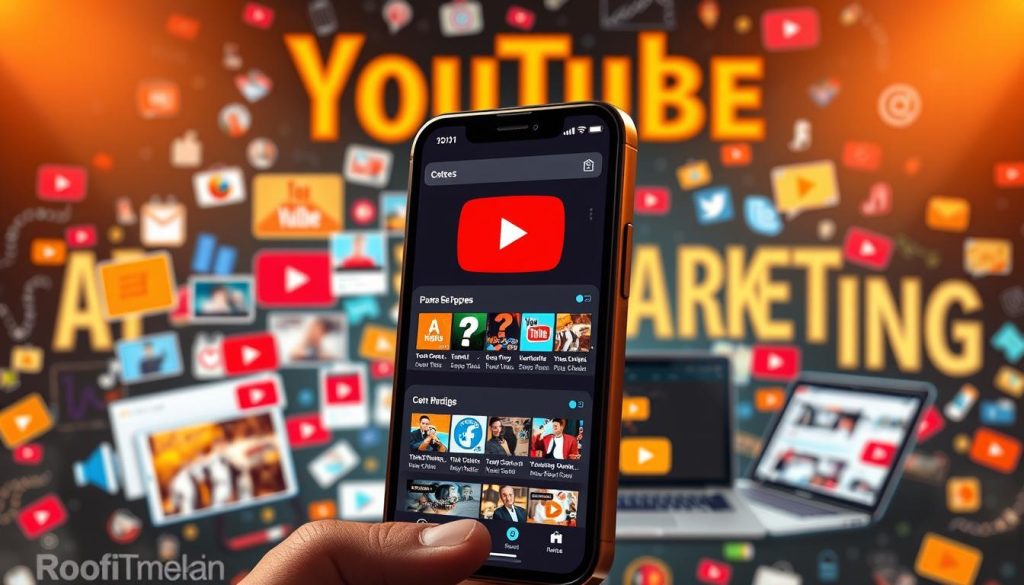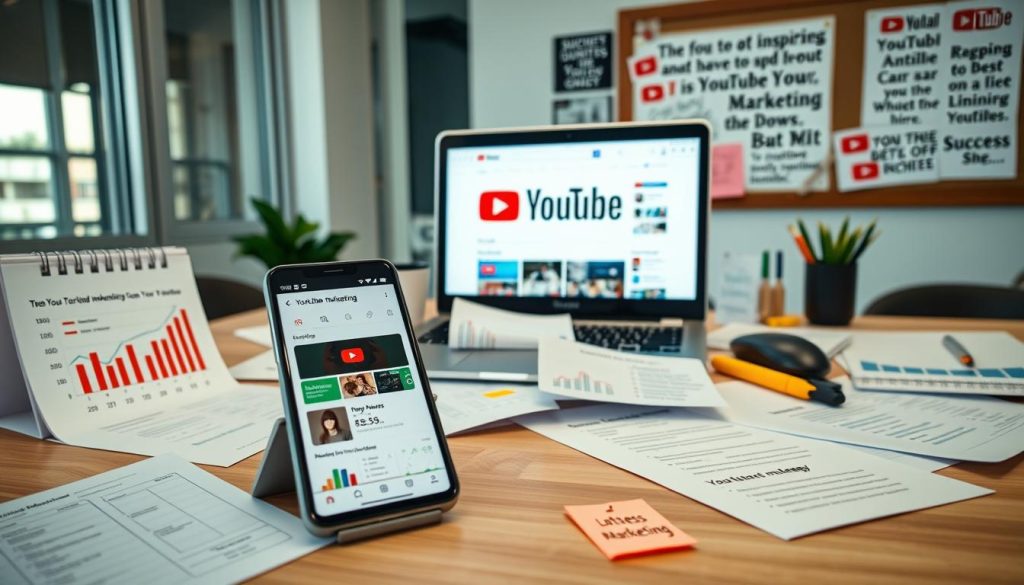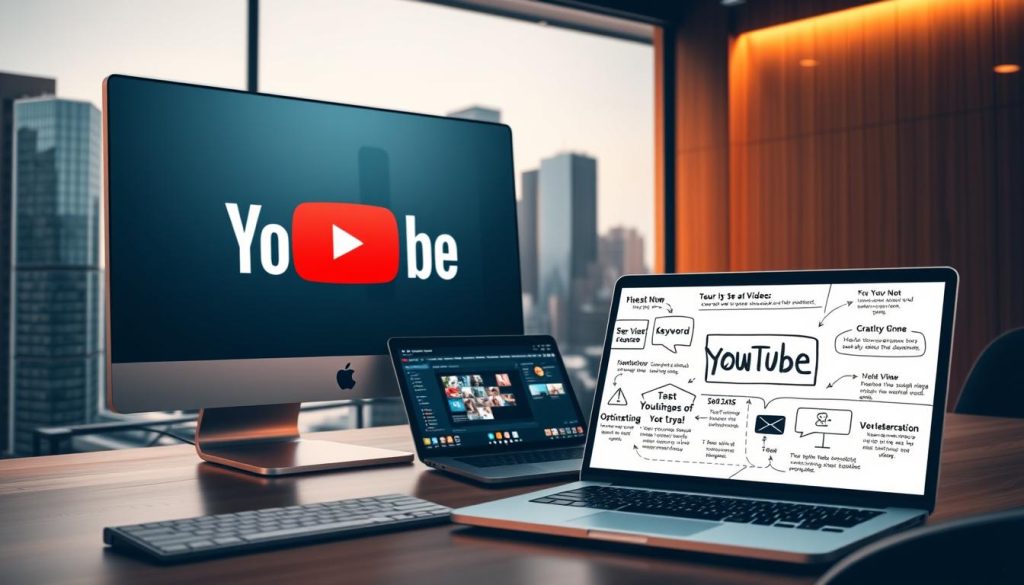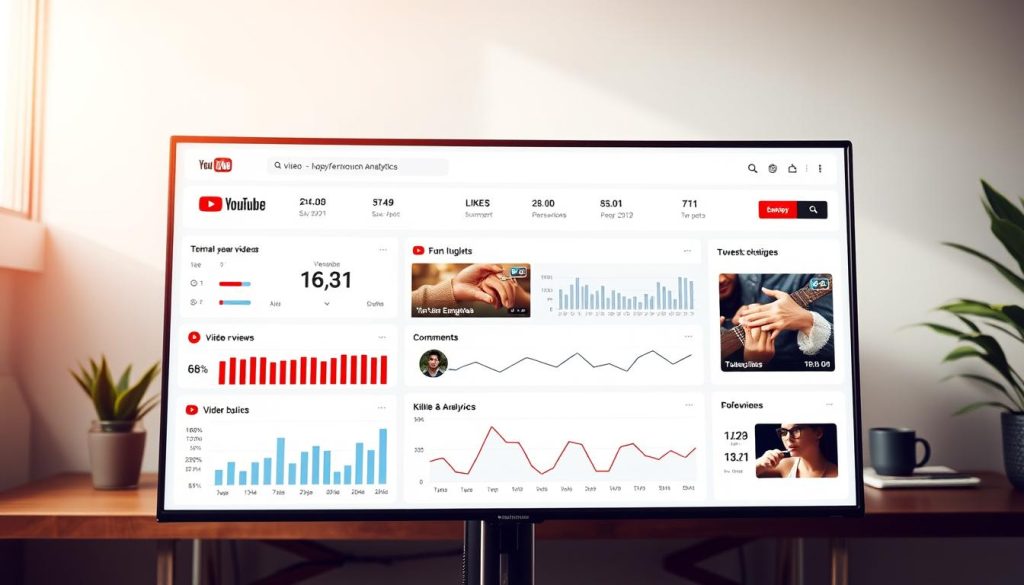In the ever-evolving digital landscape, businesses need effective strategies to reach their target audience. With over 2 billion monthly active users, YouTube has become a powerful platform for online video marketing.
We will guide you through the process of creating a successful YouTube marketing strategy that drives results. A well-crafted plan can help businesses increase engagement and achieve their goals.
Key Takeaways
- Understand the importance of YouTube in the digital landscape
- Learn how to create a YouTube marketing plan that drives business growth
- Discover strategies to increase engagement and reach your target audience
- Implement best practices for a successful YouTube marketing campaign
- Achieve your business goals with a data-driven YouTube marketing approach
What is YouTube Marketing?
As the world’s second-largest search engine, YouTube presents a vast opportunity for businesses to market their products and services through video content. YouTube marketing involves creating and promoting video content on YouTube to reach and engage with a target audience.
Definition and Importance
YouTube marketing is crucial for businesses due to YouTube’s vast user base and the platform’s influence on consumer behavior. Effective YouTube marketing strategies can significantly enhance brand visibility, drive website traffic, and generate leads. We will leverage YouTube’s advertising capabilities to reach our target audience more effectively.

Key Statistics
YouTube’s vast reach and engagement make it an ideal platform for marketing. Some key statistics that underscore YouTube’s potential include:
- Over 2 billion logged-in monthly users
- Over 1 billion hours of video watched daily
- Mobile devices account for 70% of YouTube’s total watch time
These statistics highlight the importance of incorporating YouTube into a comprehensive digital marketing strategy.
Types of YouTube Marketing
There are primarily two types of YouTube marketing strategies: organic and paid. Organic YouTube marketing involves optimizing video content to rank higher in YouTube’s search results, thereby increasing visibility and engagement without directly paying for ads. On the other hand, paid YouTube advertising allows businesses to promote their videos through various ad formats, targeting specific demographics and interests to reach their desired audience more effectively.
By understanding and leveraging both organic and paid YouTube marketing strategies, businesses can create a robust online presence and achieve their marketing goals.
Setting Clear Marketing Goals
Establishing clear marketing goals is the foundation of a successful YouTube marketing strategy. We recognize that without well-defined objectives, it’s challenging to create focused content and measure the success of our efforts.
Clear goals help guide our content creation process, ensuring that our videos resonate with our target audience and drive meaningful engagement. By setting specific, measurable objectives, we can better allocate resources and track progress over time.

Brand Awareness
One of the primary goals of YouTube marketing is to increase brand awareness. By creating high-quality, engaging content, we can expand our reach and introduce our brand to new audiences. Effective brand awareness strategies on YouTube include:
- Producing consistent, high-quality content that reflects our brand’s values and mission.
- Utilizing keywords and tags that are relevant to our target audience’s search queries.
- Engaging with our viewers through comments and community posts to build a loyal following.
Lead Generation
Another critical goal is lead generation. By creating content that addresses the needs and pain points of our target audience, we can attract potential customers and encourage them to take action. Strategies for lead generation on YouTube include:
- Creating informative, problem-solving content that showcases our expertise.
- Including clear calls-to-action (CTAs) in our videos and video descriptions.
- Utilizing YouTube’s lead generation cards to capture viewer information directly within the platform.
Direct Sales
For many businesses, the ultimate goal of YouTube marketing is to drive direct sales. By creating compelling content that showcases our products or services, we can encourage viewers to make a purchase. Effective strategies for driving direct sales on YouTube include:
- Creating product demos or reviews that highlight the benefits and features of our offerings.
- Utilizing YouTube’s shopping feature to tag products directly in our videos.
- Offering exclusive promotions or discounts to our YouTube audience to incentivize purchases.
As Forbes notes, “Setting clear goals is essential for any marketing strategy, and YouTube is no exception.” By setting clear marketing goals and creating content that aligns with these objectives, we can maximize the effectiveness of our YouTube marketing efforts and achieve tangible results.
“The key to success on YouTube is to be consistent, be patient, and be authentic.” –
Understanding Your Target Audience
The foundation of a winning YouTube marketing plan lies in understanding your target audience. To create content that resonates and drives results, you need to know who you’re creating it for.
We delve into the importance of understanding your target audience for YouTube marketing success. This involves analyzing demographics, viewer behavior, and creating detailed audience personas to guide content creation.
Identifying Demographics
Identifying the demographics of your target audience is crucial. This includes understanding their age, gender, location, and interests. YouTube provides valuable insights into your viewers’ demographics through its analytics tools.
For instance, you can use YouTube Analytics to discover the age and gender distribution of your viewers, as well as their geographical locations. This information helps tailor your content to better suit your audience’s preferences.
| Demographic | Description | Importance |
|---|---|---|
| Age | The age range of your viewers | Helps in creating age-relevant content |
| Gender | The gender distribution of your audience | Aids in tailoring content to specific gender interests |
| Location | Geographical locations of your viewers | Assists in localizing content or targeting specific regions |
Viewer Behavior Analysis
Analyzing viewer behavior is another critical aspect of understanding your target audience. This involves studying how viewers interact with your content, including watch time, engagement, and drop-off points.
By examining viewer behavior, you can identify patterns and preferences that inform your content strategy. For example, if you notice that viewers tend to drop off at a certain point in your videos, you can adjust your content to be more engaging during those segments.
For more insights on viewer behavior, you can refer to YouTube’s official support resources.

Creating Audience Personas
Creating detailed audience personas is a powerful way to encapsulate your understanding of your target audience. Personas are fictional representations of your ideal viewers, based on the data you’ve collected about demographics and viewer behavior.
By creating personas, you can humanize your audience and make more informed decisions about your content strategy. For instance, you can tailor your video titles, descriptions, and tags to appeal directly to your personas.
Effective audience personas include details such as:
- Demographics (age, gender, location)
- Interests and preferences
- Behavioral patterns (watch time, engagement)
- Goals and challenges related to your content
By understanding and applying these insights, you can significantly enhance your YouTube marketing efforts, creating content that resonates with your target audience and drives meaningful results.
Creating Compelling Video Content
Video content creation is an art that requires a deep understanding of your audience and their preferences. To captivate your viewers, you need to produce high-quality, engaging videos that resonate with them.
We explore various aspects of creating compelling video content, including different video formats, storytelling techniques, and ensuring quality production.
Types of Video Formats
Different video formats can be used to engage your audience, such as tutorials, behind-the-scenes content, product reviews, and more. Tutorials are particularly effective for educating your audience about your products or services, while behind-the-scenes content humanizes your brand and builds a connection with your viewers.
- Tutorials and how-to videos
- Behind-the-scenes content
- Product reviews and demonstrations
- Vlogs and personal stories
- Testimonials and case studies
Storytelling Techniques
Storytelling is a powerful tool in video content creation. It allows you to connect with your audience on an emotional level, making your brand more relatable and memorable. Effective storytelling involves creating a narrative that resonates with your viewers, often through a mix of visuals, music, and narrative.
“Storytelling is the most powerful way to put ideas into the world today.” – Robert McKee
To incorporate storytelling into your videos, focus on creating a compelling narrative, using emotional triggers, and highlighting the human aspect of your brand.
Ensuring Quality Production
Ensuring high-quality production is crucial for maintaining viewer engagement. This involves investing in good camera equipment, sound quality, and editing software. High-quality visuals and clear audio significantly enhance the viewing experience, making your content more enjoyable and professional.

By focusing on these aspects, you can significantly improve the quality of your video content, making it more engaging and effective in achieving your marketing goals.
Optimizing Videos for SEO
To stand out on YouTube, mastering video SEO is essential. We help you understand the critical components that make your video content more discoverable and rank higher in search results.
Keywords and Tags
Keyword research is the foundation of a successful YouTube SEO strategy. We identify relevant keywords that your target audience uses to search for content like yours. Incorporating these keywords into your video’s metadata, such as tags, titles, and descriptions, improves its visibility.
Effective keyword research involves:
- Using tools like Google Keyword Planner or TubeBuddy to find relevant keywords.
- Analyzing competitors’ keywords and content strategies.
- Selecting a mix of niche and broad keywords to balance specificity and reach.
Thumbnails and Titles
Your video’s thumbnail and title are the first things viewers see, making them crucial for click-through rates. We craft thumbnails that are visually appealing and titles that are both informative and enticing.
Best practices for thumbnails and titles include:
| Element | Best Practice |
|---|---|
| Thumbnail | Use bright, contrasting colors and clear imagery. |
| Title | Include your primary keyword and make it descriptive yet concise. |
Video Descriptions
A well-written video description provides context to your content and helps YouTube understand its relevance. We ensure that descriptions are detailed, include relevant keywords, and encourage viewer engagement.
Key elements of effective video descriptions:
- A brief summary of the content.
- Inclusion of primary and secondary keywords.
- Links to relevant resources or next steps.

By focusing on these SEO strategies, we can significantly improve your video’s visibility and ranking on YouTube.
Utilizing YouTube Advertising Options
Effective YouTube marketing involves more than just content creation; it requires strategic advertising. YouTube offers a variety of advertising options that can help businesses reach their target audience more effectively.
Different Ad Formats
YouTube provides several ad formats to suit different marketing objectives. These include:
- TrueView Ads: These are skippable video ads that allow viewers to skip the ad after 5 seconds. They are charged on a cost-per-view (CPV) basis.
- Bumper Ads: Non-skippable, short video ads (up to 6 seconds) that are ideal for increasing brand awareness.
- Display Ads: These appear to the right of the YouTube video and above the video suggestions list.
- Sponsored Cards: These are used to promote products or services relevant to the video content.
Remarketing Strategies
Remarketing on YouTube allows businesses to re-engage with users who have previously interacted with their content or website. This can be a powerful way to nurture leads and encourage conversions. To implement remarketing strategies effectively:
- Identify your target audience based on their past interactions.
- Create tailored ad content that resonates with this audience.
- Set up remarketing campaigns through Google Ads, linking them to your YouTube channel.
Budgeting for Ad Spend
Budgeting is a critical aspect of any advertising campaign. For YouTube ads, you need to decide on a daily budget and bid strategy. YouTube offers flexible budgeting options, allowing you to control your ad spend effectively. Consider the following when budgeting:
- Cost-Per-View (CPV): You pay when a viewer watches your ad for a certain duration or until the end.
- Cost-Per-Thousand Impressions (CPM): You pay for every 1,000 times your ad is displayed.
By understanding and utilizing these YouTube advertising options, businesses can enhance their marketing efforts, reach a wider audience, and drive meaningful results.
Analyzing Video Performance Metrics
Understanding how your YouTube videos perform is key to refining your marketing strategy and achieving better results. By analyzing video performance metrics, we can gain valuable insights into viewer behavior, identify areas for improvement, and optimize our content for maximum impact.
Key Performance Indicators (KPIs)
To effectively analyze video performance, we need to focus on key metrics that matter. Some of the most important KPIs for YouTube videos include:
- Watch time: The total amount of time viewers spend watching your videos.
- Engagement: Likes, comments, and shares that indicate how viewers interact with your content.
- Click-through rate (CTR): The percentage of viewers who click on your video after seeing it in search results or recommendations.
- Audience retention: How well your video holds viewers’ attention throughout.
As HubSpot notes, “Video metrics can help you understand your audience and create more effective content.” By tracking these KPIs, we can get a comprehensive picture of our video’s performance.
Tools for Analysis
To analyze these KPIs effectively, we need the right tools. YouTube provides a robust analytics platform that offers detailed insights into video performance. Some key features of YouTube Analytics include:
- Real-time data: Track views, watch time, and other metrics as they happen.
- Video performance reports: Detailed breakdowns of how individual videos are performing.
- Audience insights: Demographic data and viewer behavior analysis.

Additionally, third-party tools like Tubular Labs and VidIQ can provide further insights and help us optimize our YouTube strategy.
Interpreting Data for Improvement
Collecting data is just the first step; interpreting it correctly is crucial for making informed decisions. By analyzing our KPIs, we can identify trends, spot issues, and opportunities for growth. For instance, if our audience retention is low, it may indicate that our content isn’t engaging enough. As
“The goal is to turn data into insights that drive action.”
By regularly reviewing our video performance metrics, we can refine our content strategy, improve engagement, and ultimately drive better results for our YouTube marketing efforts.
Promoting Your YouTube Channel
Effective YouTube channel promotion requires a combination of organic strategies, collaborations, and social media integration. To achieve significant growth, we need to employ a multifaceted approach that caters to our target audience’s preferences and behaviors.
Organic Promotion Strategies
Organic promotion is crucial for long-term success on YouTube. We can start by optimizing our video titles, descriptions, and tags with relevant keywords. This helps improve our video’s visibility in search results.
- Use attention-grabbing titles that include primary keywords.
- Write detailed video descriptions that provide context and include secondary keywords.
- Utilize relevant tags to help YouTube understand the content of our videos.
Engaging with our audience is also vital. We should respond to comments, ask for feedback, and encourage viewers to subscribe and share our content.
Collaborations and Influencer Marketing
Collaborating with other creators and influencers can significantly boost our channel’s growth. By partnering with influencers in our niche, we can tap into their audience and gain credibility.
To execute a successful collaboration:
- Identify potential collaborators or influencers who align with our brand values.
- Propose a mutually beneficial collaboration idea, such as a joint video or series.
- Ensure that the collaboration is authentic and engaging for both our audiences.
Social Media Integration
Integrating our YouTube channel with other social media platforms is essential for maximizing our reach. We should share our YouTube content on platforms like Facebook, Twitter, Instagram, and LinkedIn.
To effectively integrate our YouTube channel with social media:
- Share teasers or snippets of our YouTube videos to drive traffic to our channel.
- Utilize social media advertising to promote our YouTube content to a broader audience.
- Engage with our followers on social media by responding to comments and messages.
Best Practices for YouTube Marketing Success
To achieve success with YouTube marketing, we must focus on key strategies that drive results. By implementing these best practices, businesses can develop a sustainable and effective YouTube marketing strategy.
Consistency is Key
Maintaining consistency in video uploads is crucial for keeping your audience engaged. We recommend creating a content calendar to schedule videos in advance, ensuring a steady stream of content that resonates with your viewers.
Engage with Your Audience
Engaging with your audience is vital for building a loyal following. We suggest responding to comments, asking for feedback, and using youtube video promotion techniques to encourage audience participation.
Stay Ahead of the Curve
Staying updated on YouTube trends and algorithm updates is essential for staying ahead of the competition. We advise regularly checking YouTube’s official blog and staying informed about the latest developments in YouTube marketing to ensure your strategy remains effective.
By following these best practices, including staying updated on youtube trends, businesses can optimize their YouTube marketing strategy and achieve their marketing goals.
